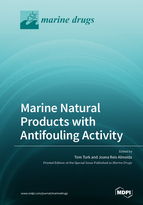Marine Natural Products with Antifouling Activity
A special issue of Marine Drugs (ISSN 1660-3397).
Deadline for manuscript submissions: closed (15 May 2021) | Viewed by 38016
Special Issue Editors
Interests: marine natural compounds; antifouling; toxicity; coatings; environment
Special Issues, Collections and Topics in MDPI journals
Interests: marine biology and ecology; marine environmental health; marine biotechnology; sustainable antifouling strategies; natural bioactive metabolites; bioproducts and biomaterials
Special Issues, Collections and Topics in MDPI journals
Special Issue Information
Dear Colleagues,
Marine fouling affects most man-made surfaces temporarily or permanently immersed in the sea, causing important economic costs. Intense research is aimed at methods for preventing or reducing fouling development. The most widespread solution to inhibit fouling is to make surfaces unsuitable for settlers by coating them with antifouling paints containing toxic compounds. Most such antifouling agents give undesirable effects on nontarget species, including commercially important ones. The search for new nontoxic antifouling technologies has become a necessity, particularly after the ban of organotin compounds such as tributyltin (TBT), once the most widespread and used antifouling agent. Alternative organic and metal-based biocides are now used in antifouling paints, but their possible toxic effects on the aquatic environment are not yet fully understood. A nontoxic alternative for antifouling protection comes from the possibility of adopting natural antifouling compounds that are and may be found in marine sessile invertebrates like sponges, bryozoans, corals, and tunicates. Such metabolites prevent their producers from being fouled on by other organisms. As natural marine compounds, they may inhibit settlement through a nontoxic mechanism without adverse effects to the environment. Such compounds could be developed into active ingredients of new antifouling coatings. So far, a rather limited number of natural product antifoulants (NPAs) has been isolated from marine organisms, but a huge reservoir of compounds with potential antifouling activity is hidden in marine organisms. The Special Issue on marine natural products with antifouling activity aims at the discovery of such compounds their activity, toxicit,y and potential application in environmentally friendly antifouling coatings.
Prof. Tom Turk
Dr. Joana Reis Almeida
Guest Editors
Manuscript Submission Information
Manuscripts should be submitted online at www.mdpi.com by registering and logging in to this website. Once you are registered, click here to go to the submission form. Manuscripts can be submitted until the deadline. All submissions that pass pre-check are peer-reviewed. Accepted papers will be published continuously in the journal (as soon as accepted) and will be listed together on the special issue website. Research articles, review articles as well as short communications are invited. For planned papers, a title and short abstract (about 100 words) can be sent to the Editorial Office for announcement on this website.
Submitted manuscripts should not have been published previously, nor be under consideration for publication elsewhere (except conference proceedings papers). All manuscripts are thoroughly refereed through a single-blind peer-review process. A guide for authors and other relevant information for submission of manuscripts is available on the Instructions for Authors page. Marine Drugs is an international peer-reviewed open access monthly journal published by MDPI.
Please visit the Instructions for Authors page before submitting a manuscript. The Article Processing Charge (APC) for publication in this open access journal is 2900 CHF (Swiss Francs). Submitted papers should be well formatted and use good English. Authors may use MDPI's English editing service prior to publication or during author revisions.
Keywords
- marine natural compounds
- antifouling
- toxicity
- coatings
- environment








